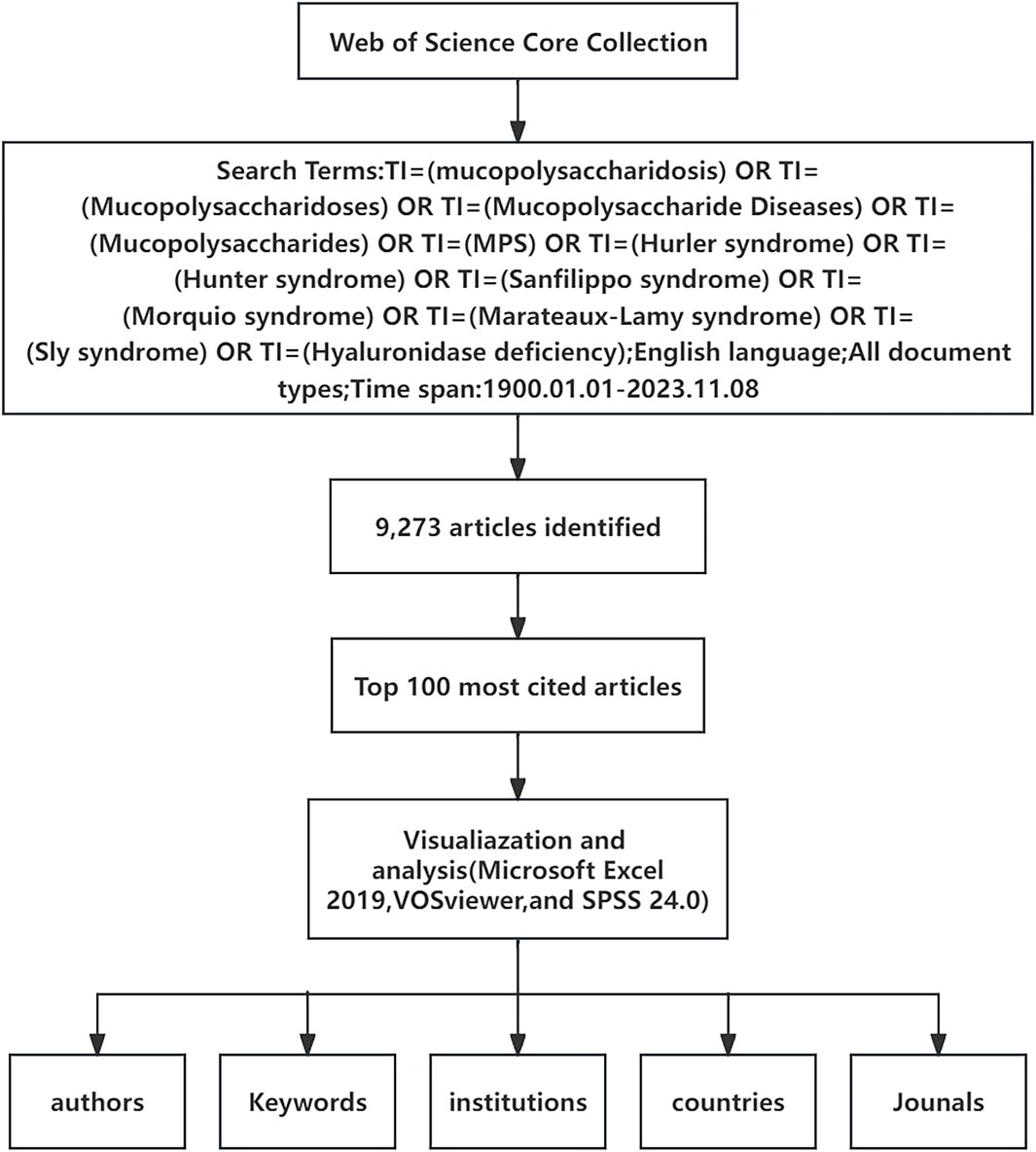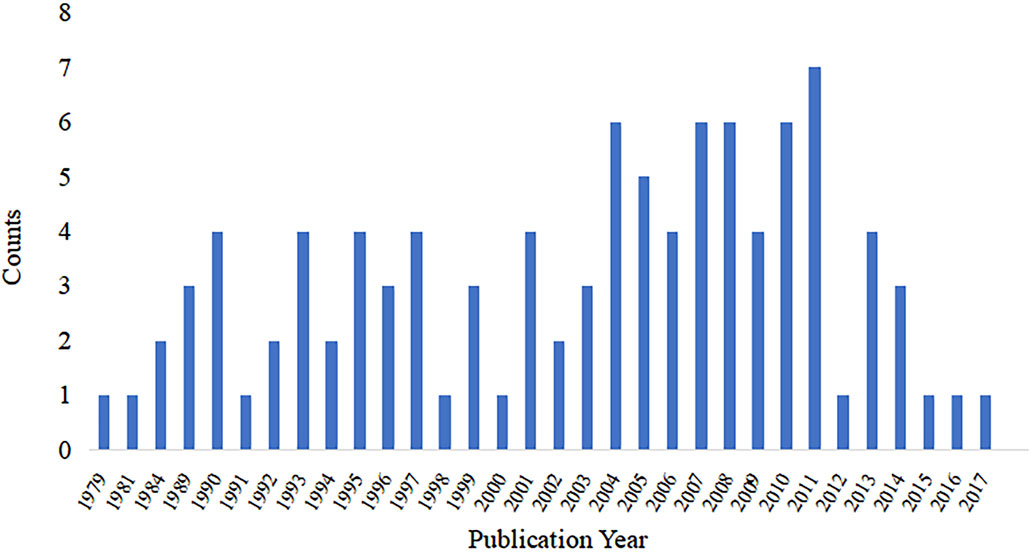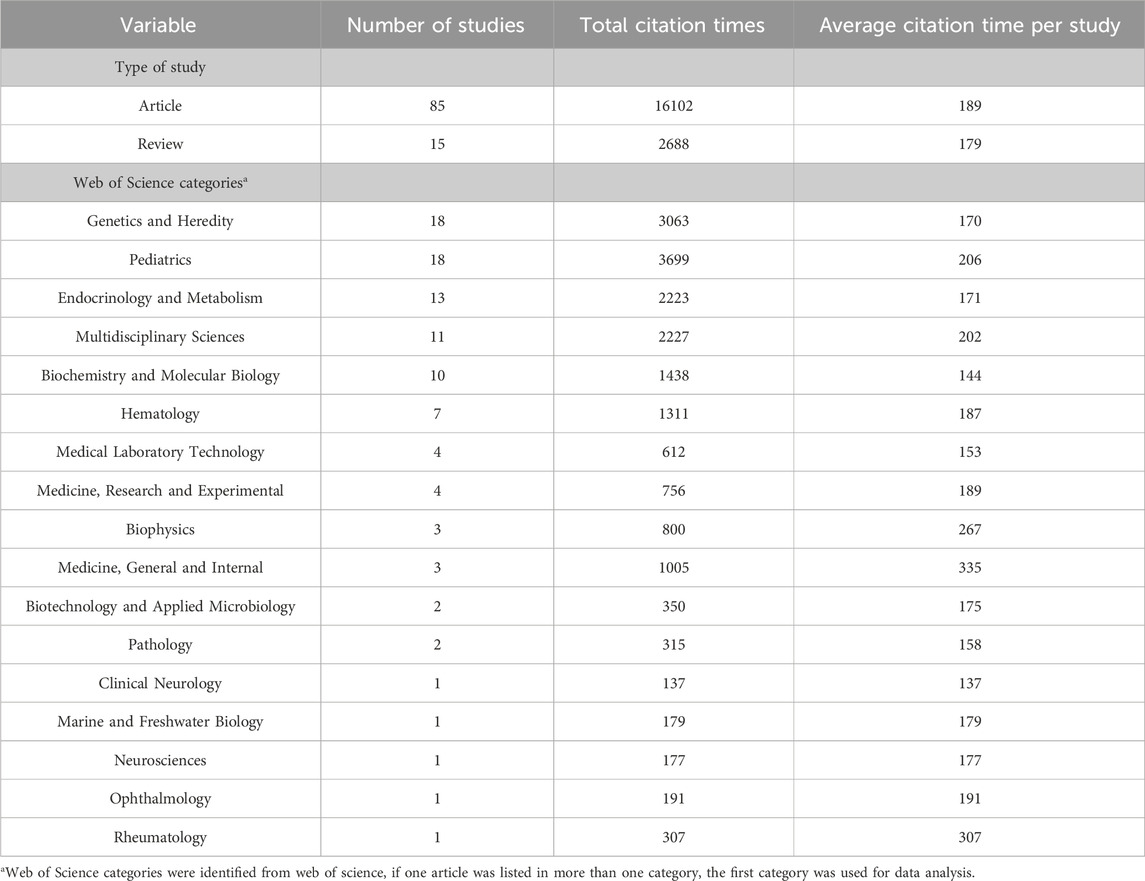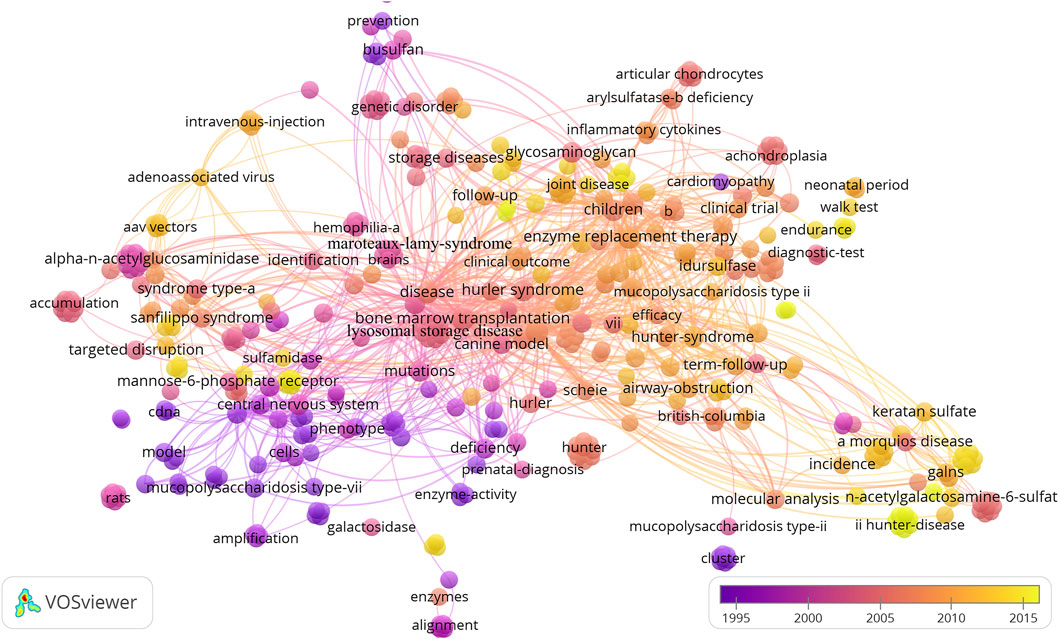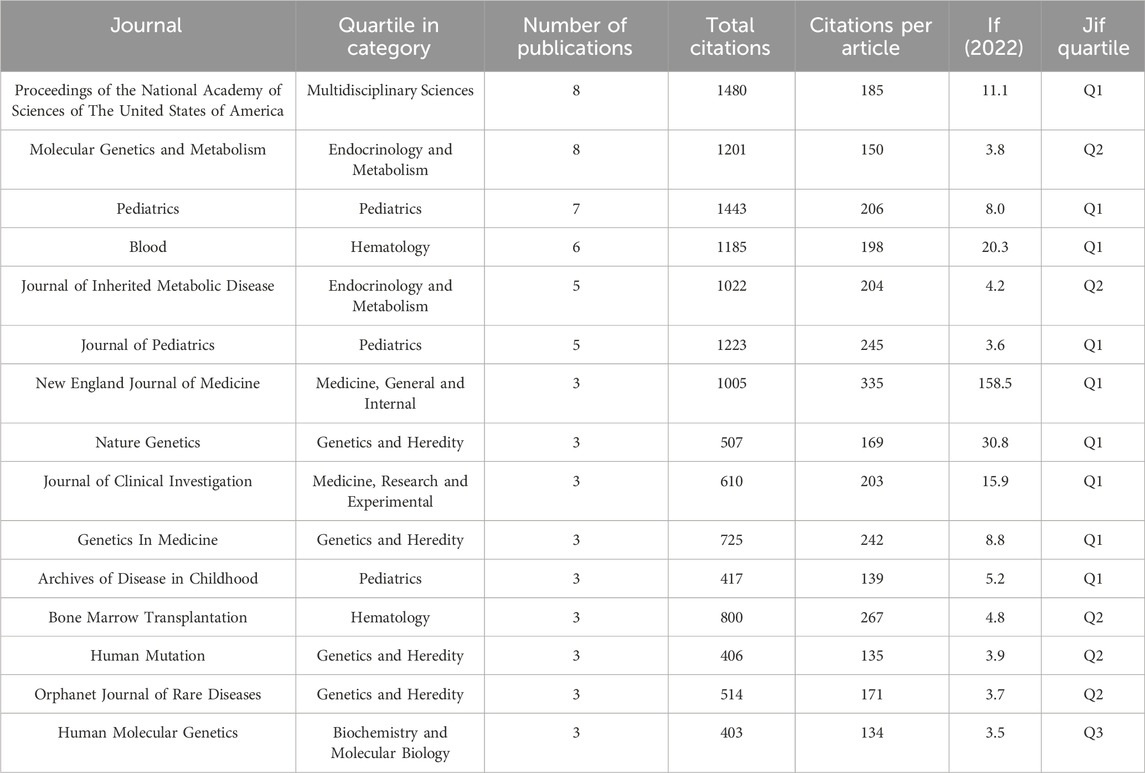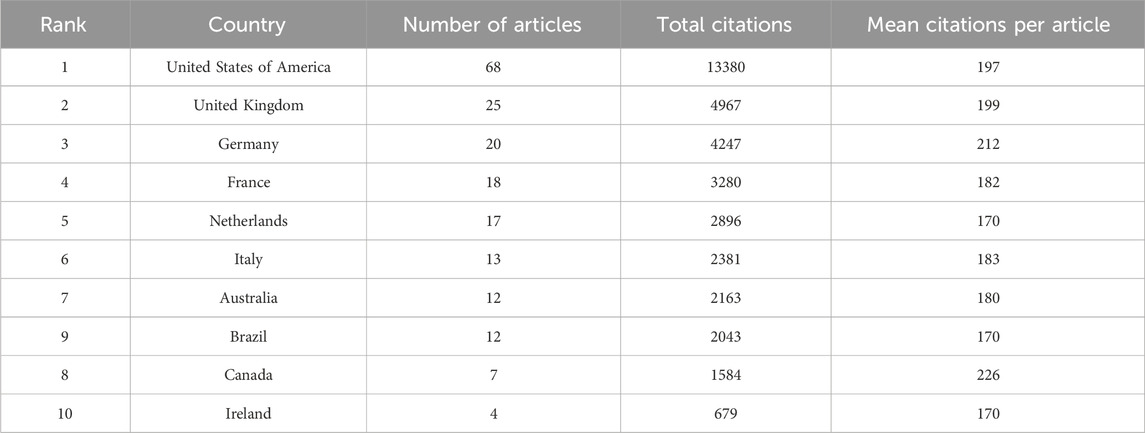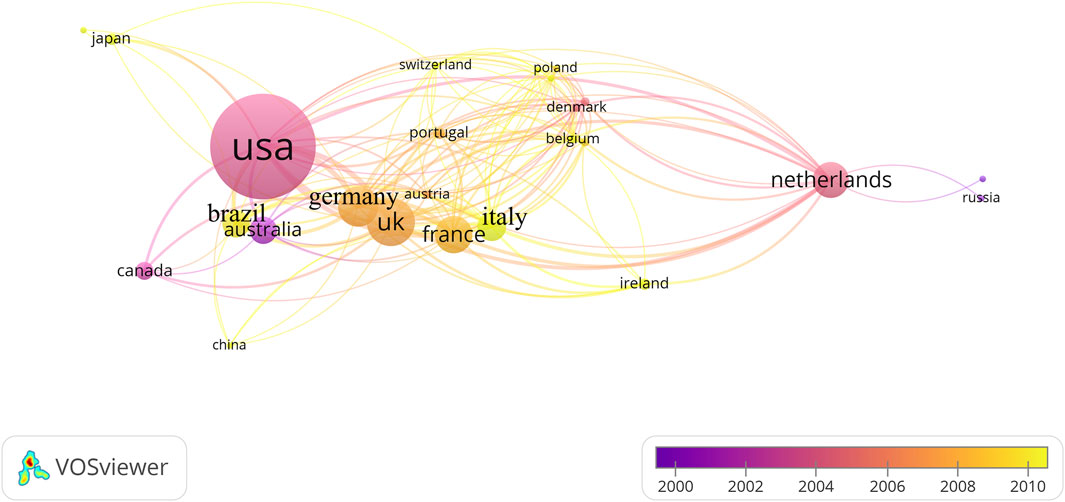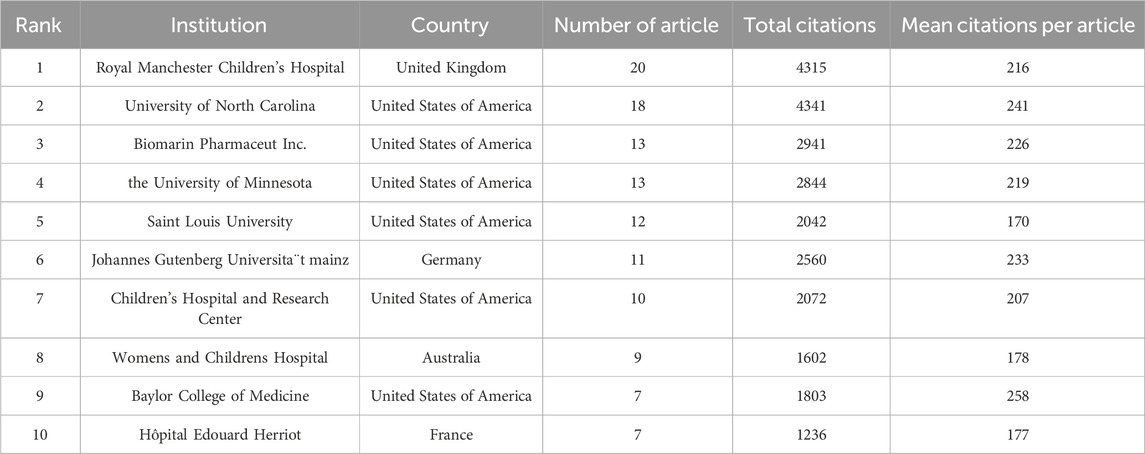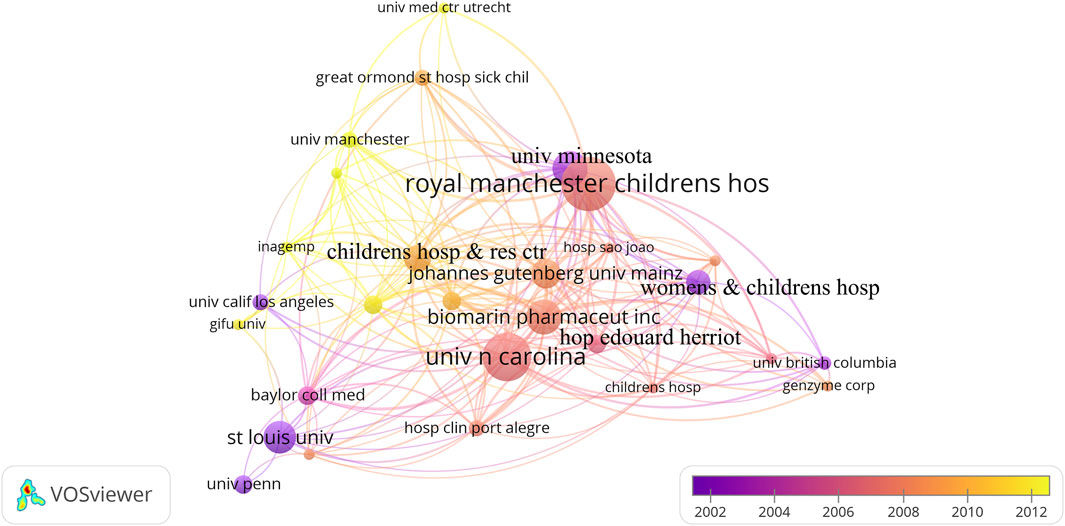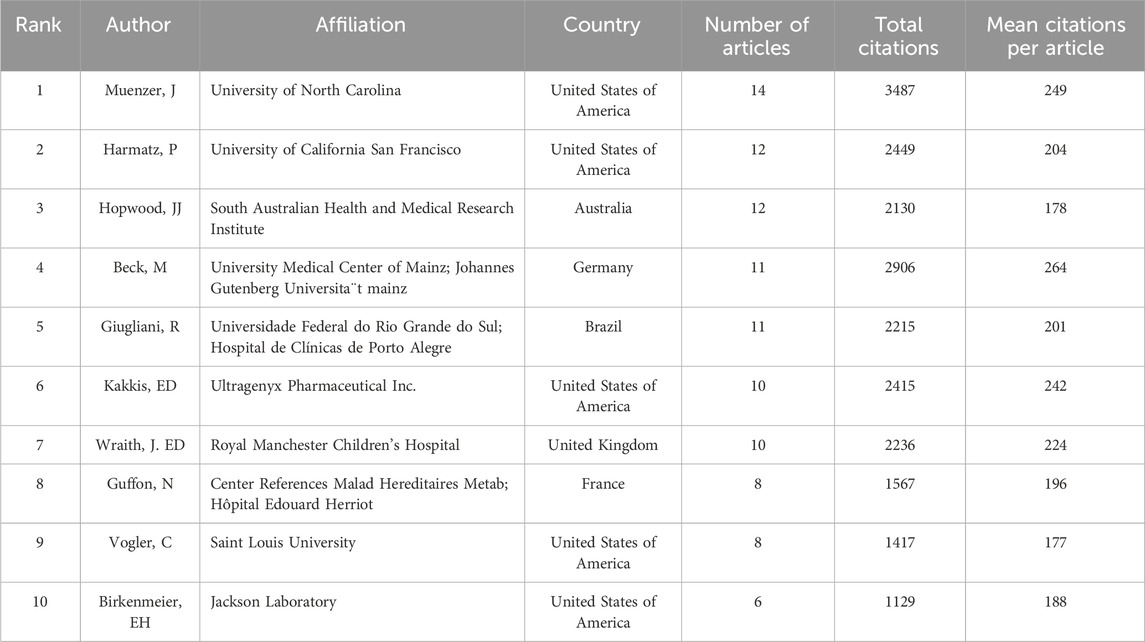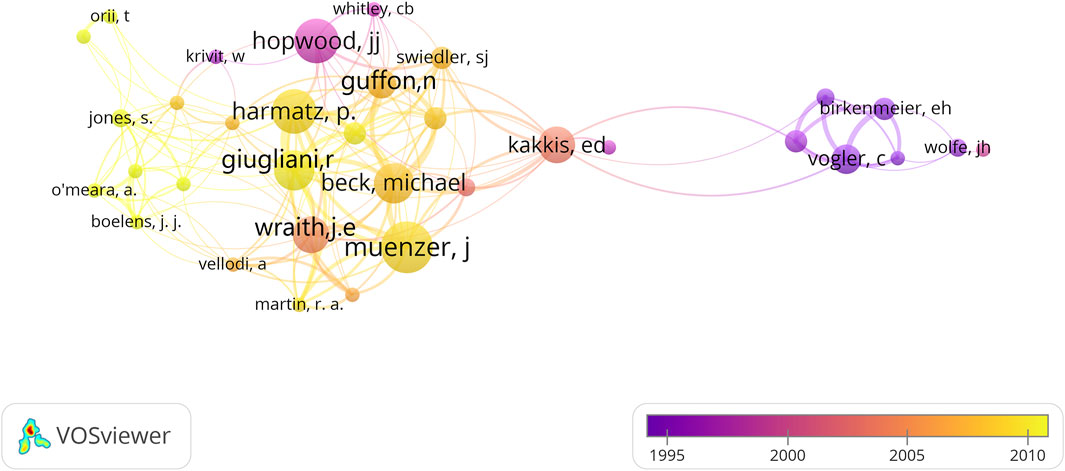- Department of Orthopedics, The Third People’s Hospital of Chengdu, Chengdu, China
Background: Bibliometrics can trace general research trends in a particular field. Mucopolysaccharidoses (MPS), as a group of rare genetic diseases, seriously affect the quality of life of patients and their families. Scholars have devoted themselves to studying MPS’s pathogenesis and treatment modalities and have published many papers. Therefore, we conducted a bibliometric and visual study of the top 100 most highly cited articles to provide researchers with an indication of the current state of research and potential directions in the field.
Methods: The Web of Science Core Collection was searched for articles on MPS from 1 January 1900, to 8 November 2023, and the top 100 most cited articles were screened. The title, year of publication, institution, country, and first author of the articles were extracted and statistically analyzed using Microsoft Excel 2007. Keyword co-occurrence and collaborative networks were analyzed using VOSviewer 1.6.16.
Results: A total of 9,273 articles were retrieved, and the top 100 most cited articles were filtered out. The articles were cited 18,790 times, with an annual average of 188 citations (122–507). Forty-two journals published these articles, with Molecular Genetics and Metabolism and Proceedings of the National Academy of Sciences of the United States being the most published journal (N = 8), followed by Pediatrics (N = 7), Blood (N = 6). The United States (N = 68), the UK (N = 25), and Germany (N = 20) were the top contributing countries. The Royal Manchester Children’s Hospital (N = 20) and the University of North Carolina (N = 18) were the most contributing institutions. Muenzer J was the most prolific author (N = 14).
Conclusion: We conducted a bibliometric and visual analysis of the top 100 cited articles in MPS. This study identifies the most influential articles currently available in the field of MPS, which provides a good basis for a better understanding of the disease and informs future research directions.
1 Introduction
Mucopolysaccharidoses (MPSs) are a rare and heterogeneous group of inherited lysosomal storage disorders that can be classified into seven major disorders, including 11 subtypes (Kobayashi, 2019). The combined incidence of all MPS ranges from 1.53 to 4.8 cases per 100,000 live births and is characterized by progressive multiorgan involvement (Pinto et al., 2004; Khan et al., 2017). MPS is caused by defects in genes coding for different lysosomal enzymes degrading glycosaminoglycans (GAG), such as heparan sulfate (HS), chondroitin sulfate (CS), dermatan sulfate (DS) and keratan sulfate (KS). The deficient enzyme activity leads to systemic storage of GAG and a wide range of clinical manifestations (Puckett et al., 2021). For example, accumulation of GAG in growth plates and articular cartilage accelerates chondrocyte apoptosis and inflammation, leading to growth failure, limited joint range of motion, and reduced mobility (Clarke, 2011). Accumulation of GAG in the eye can lead to a variety of ocular comorbidities such as corneal clouding, glaucoma, retinopathy, and ocular nerve involvement, which can result in visual disability (Nagpal et al., 2022). There are also significant neurocognitive symptoms associated with MPS, such as developmental delays, behavioral disorders, and hydrocephalus (Shapiro and Eisengart, 2021). These disease manifestations seriously affect the quality of life of patients and their families. Scholars have devoted themselves to studying the pathogenesis and treatment modalities of MPS, exploring the efficacy and pitfalls of therapeutic modalities such as hematopoietic stem cell transplantation (HSCT), enzyme replacement therapy (ERT), and gene therapy (GT), and many papers have been published.
Citation analysis is essential to bibliometrics, identifying the most influential works in MPS(J. J. Zhou et al., 2017; Zhu et al., 2021). In general, the more citations an article has received, the more valuable and significant it is in the field (Kreutzer et al., 2017). Identifying the most cited works is crucial for clinicians or researchers in related fields to identify the most active areas and help guide future work. Therefore, this method is widely used in other areas of literature analysis (Karslı and Tekin, 2021; Liu et al., 2022) to identify high-quality articles in the field. However, few analyses have reported the most cited works on MPS. Hence, this study aimed to conduct a longitudinal review of the research in this field to provide a comprehensive picture of the research in the field and to identify the top 100 most cited articles on MPS in Web of science (WoS) in an effort to identify important contributions to the literature in the field as well as to provide direction for future research.
2 Materials and methods
2.1 Data sources
The number of citations of the same article in different databases is not the same, in order to avoid inconsistency in the results, so we choose only one database to search (Zhang et al., 2023). The Web of Science Core Collection (WoSCC) is the most extensively utilized database in academic research (L. Chen et al., 2023; Liu et al., 2024; Zhou et al., 2023), so we searched the WoSCC for articles related to MPS and sorted them in descending order of citations to filter the top 100 most-cited articles. The search was performed using the following terms: TI=(mucopolysaccharidosis) OR TI=(Mucopolysaccharidoses) OR TI=(Mucopolysaccharide Diseases) OR TI=(Mucopolysaccharides) OR TI=(MPS) OR TI=(Hurler syndrome) OR TI=(Hunter syndrome) OR TI=(Sanfilippo syndrome) OR TI=(Morquio syndrome) OR TI=(Marateaux-Lamy syndrome) OR TI=(Sly syndrome) OR TI=(Hyaluronidase deficiency), the language is set to English, the type of article is not limited, and the period from 1 January 1900 to 8 November 2023. Two investigators agreed on the search terms and independently screened the articles by reading the abstract or full text. If disagreements were encountered, a third researcher exercised judgment. This study did not require ethical approval as all data were obtained from publicly available WoS databases. (Figure 1).
2.2 Data extraction and organization
We extracted the following data from each article: title of the article, year of publication, first author, research institution and country (whichever is the first author), name of the journal in which the article was published, Journal Citation Reports (JCR) partition (if there are more than one partition, the highest division counts), impact factor, number of citations, type of article, average number of citations received after publication of each article, and WOS category (if it belongs to more than one category, the first one will be the most important). For the country information extracted from the study, we categorized Taiwan as China (Gao et al., 2019; Huang et al., 2023).
2.3 Statistical analysis
Descriptive statistical analysis of the articles was performed using Microsoft EXCEL 2007, containing title, year of publication, journal of publication, overall number of citations, average number of citations, impact factor, etc.; Correlation analysis was performed using SPSS 24.0, using the Pearson’s correlation coefficient (R) to determine that the difference was considered statistically significant when p < 0.05; Knowledge graphical analysis was performed using VOSviewer1.6.16 for knowledge graph analysis to map the collaborative network between countries, institutions and authors. The network contains three features: node size, connectivity, and color. A node represents a specific element such as country, author, or institution; the node’s size indicates the number or frequency of publications, and the node’s color indicates the year in which the article was published. The lines between nodes represent the number of times they appear together.
3 Result
3.1 Descriptive statistics
Based on the above search formula, we retrieved 9,273 articles related to MPS and filtered out the top 100 most cited documents.
3.2 Publication year, citation
Years of publication for the top 100 articles ranged from 1979 to 2017, articles published in 2018–2023 were not included. The annual publication rate varied from one to seven articles per year, with a majority of the articles (69%) being published since 1998. Notably, the highest number of articles (n = 7) was published in 2011. (Figure 2).
The top 100 articles were cited 18,790 times, with an annual average of 188 citations (122–507). There were 23 articles with more than 200 citations. A highly significant correlation existed between total citations and average annual citations (rs = 0.653, p < 0.001). There was no significant correlation between total citations and article age (rs = −0.007, p = 0.946). There was a significant correlation between average annual citations and article age (rs = −0.668, p < 0.001).
3.3 Article types and contents
The articles were ranked in descending order of citations to obtain the top 100 highly cited articles (Table 1). Among them, 85 were original articles and 15 were review articles.
We found these articles mainly focused on the epidemiology, drug treatment trials, animal experiments, identification and diagnosis, management, and treatment guidelines of MPS by reading the titles or abstracts. These articles belong to 17 categories of Web of Science, of which the top three are Genetics and Heredity (N = 18), Pediatrics (N = 18), and Endocrinology and Metabolism (N = 13) (Table 2). Bone marrow transplantation (BMT), enzyme replacement therapy, lysosomal storage disease, hurler syndrome, hunter-syndrome, and central nervous system (CNS) were the high-frequency keywords that appeared (Figure 3).
3.4 Journal analysis
Forty-two journals published these articles; Table 3 shows the top 10 journals with more than three publications. Of these, Molecular Genetics and Metabolism and Proceedings of the National Academy of Sciences of the United States of America was the most published journal (N = 8), followed by Pediatrics (N = 7). The IF of 42 journals varied from 1.2 to 158.5. There were 22 journals with an IF < 5.000, 11 from 5.000–10.000, nine with an IF > 10.000, and three journals with an IF > 40. Three journals were not included in the 2022 edition of the JCR. The journal with the highest IF (158.5) was the New England Journal of Medicine, which published three of the most cited articles. Nine of the top 15 journals in the JCR are in Q1, five are in Q2, and one is in Q3.
3.5 Analysis of country
A total of 25 countries published these 100 papers. Table 4 shows the top ten countries with the most publications. Among the top 100 most cited articles, the USA (N = 68) contributed the most, followed by the UK(N = 25) and Germany (N = 20). When ranked by the average number of citations per article, the top three are Canada (226), Germany (212), and the UK (199). A vast network of collaborations has been formed in this field, with the United States of America, UK, and Germany having very close collaborations (Figure 4).
3.6 Analysis of institution
A total of 234 institutions contributed to the one hundred articles. Table 5 shows the top 10 institutions contributing seven or more articles, six from the United States of America. The most significant contributor was Royal Manchester Children’s Hospital (N = 20) from the UK, followed by the University of North Carolina with 18 articles, Biomarin Pharmaceut Inc. and the University of Minnesota both with 13 articles. Led by the top institutions, the institutions collaborated extensively and closely, forming a more extensive collaborative network (Figure 5).
3.7 Analysis of author
557 authors contributed to 100 articles, and Table 6 shows the top 10 authors who contributed the most to these 100 articles. Muenzer J was the most prolific author, with 14 publications and 3,487 citations. This scholar mainly focused on treating MPS type II, i.e., Hunter’s syndrome (Muenzer et al., 2006; Muenzer et al., 2007; Muenzer, 2014). This was followed by Harmatz, P (N = 12) and Hopwood, JJ (N = 12). Muenzer, J and Harmatz, P are both from the United States of America, and Hopwood, JJ is from Australia. After visually analyzing author collaborations using VOSviewer and plotting the knowledge graph several times, the minimum number of author appearances was set to four (Figure 6). Most researchers do not appear in our graph because they have fewer than four articles. The nodes in the graph represent authors, and the larger the node, the greater the number of articles they have published. Extensive collaboration exists between most of the top authors.
5 Discussion
This study reviews clinical and research advances by bibliometric and visual mapping of the top 100 most cited articles in the field of MPS, with the expectation of providing new ideas to researchers. Molecular Genetics and Metabolism and Proceedings of the National Academy of Sciences of the United States of America published the highest number of papers, and the New England Journal of Medicine published the most articles with the highest average number of citations. The United States was the most productive country. The Royal Manchester Children’s Hospital was the most influential institution. Muenzer J was the most prolific author, with 14 publications. This study found that there is extensive and close collaboration between the top-ranked countries, institutions, and authors, and analyzing these collaborative networks not only visualizes the number of publications, but also reflects their connections and the evolution and development of the field as a whole, and it can help us to retrieve resources more efficiently (Liu et al., 2024).
Among the top 100 most cited articles, 27 are MPS I (11 of them on MPS IH), 11 are MPS II, nine are MPS III (four on MPS IIIA), five are MPS IV (all on MPS IVA), eight are MPS VI, three are MPS VII, one is MPS IX, and the rest of the articles do not have a clear classification of the types of MPS were not categorized. As we can see, among the 100 most cited articles, MPS I is the most popular type. The possible reason for this is that MPS I is the most common type of MPS, with a higher prevalence than the other types, and therefore there is more attention paid to it (Scott et al., 1995; Çelik et al., 2021). MPS II is the first MPS disease to be reported, and the manifestations of this disease were described in detail by Dr. Hunter in 1917 (Hunter, 1917), hence the name Hunter syndrome. However, the treatment of MPS lagged by decades. In 1968, a study by Elizabeth Neufeld et al. first found that MPS progression could be delayed or even terminated by providing deficient enzymes to MPS patients (Fratantoni et al., 1968). This result provided the framework for the modern treatment of MPS. Research in this field has been going on for more than a hundred years, but the amount of research produced is far less than the short burst of Covid19-related research (Y. Chen et al., 2021; Wang et al., 2023; Zhang et al., 2022). There are several possible reasons for this: MPS is a rare disease with a low incidence, and thus may attract less research attention (Platt, 2018); The lack of public awareness of MPS may affect the raising of research funds and the promotion of research; Due to the limited number of MPS patients, there are few clinical data available for research, which may limit the depth of research and the development of new treatment methods. Therefore, increasing the understanding of MPS and investing more research resources are of great significance to improve the diagnosis and treatment of MPS patients.
Keywords are the condensed summary of an article, and if they frequently appear together, they are considered to be a research hotspot in this field (Liu et al., 2024; Zhu and Zhang, 2021). The co-occurrence analysis of keywords in this study showed that bone marrow transplantation, enzyme replacement therapy, lysosomal storage disease, hurler syndrome, Children, alpha-l-iduronidase, hunter-syndrome, and central nervous system were the research hotspots in the field of MPS. These keywords mainly included the classification and treatment of MPS. Lysosomal storage disease (LSD) is a group of inherited metabolic diseases that includes more than 70 diseases (Parenti et al., 2021), of which MPS is a subclass. The earliest attempts to treat LSD were to use bone marrow transplantation (BMT) in patients with MPS I, also known as hematopoietic stem cell transplantation (HSCT). The success of such attempts has resulted in hundreds of patients benefiting from this treatment and extending their life expectancy (Aldenhoven et al., 2015; Rodgers et al., 2017; Taylor et al., 2019; Guffon et al., 2021). In addition, HSCT has a good effect on improving neurocognitive function. Therefore, it is also still considered a first-line treatment for MPS IH, even though it requires frequent medical interventions and creates a substantial burden of disease (Taylor et al., 2019). The findings of long-term studies and the implementation of management guidelines on enzyme replacement therapy (ERT) suggest that patients with MPS derive multiple benefits from this treatment (Giugliani et al., 2007; Muenzer et al., 2009; Muenzer et al., 2011a; Muenzer et al., 2011b; Hendriksz et al., 2014; Hendriksz et al., 2016). The most cited review article (Wraith et al., 2008) and Randomised controlled trial (RCT) article (Muenzer et al., 2006) both reported the therapeutic effect of idursulfase replacement therapy for MPS II, a weekly infusion of idursulfase (0.5 mg/kg) could significantly increase walking distance, improve lung function, increase elbow range of motion, reduce urinary GAG levels, and reduce organ size in patients with MPS II. However, conventional idursulfase does not cross the blood-brain barrier and may not improve CNS dysfunction in patients with severe MPS II. Therefore, a new generation of ERT has been developed and studied to overcome the inability of conventional ERT to reach the CNS, which will be described later.
Among the top 100 articles, there are 45 basic studies and 31 clinical studies. Basic research is the cornerstone of research in the biomedical field, and the etiology, pathogenesis, and treatment methods of MPS(Baldiotti et al., 2021). The most cited basic studies (Snyder et al., 1995) published in Nature in 1995, which transplanted p-glucuronidase-expressing neural progenitor cells into the ventricles of MPS VII neonatal mice and showed that lysosomal stores were significantly reduced or absent in both neurons and glial cells of treated MPS VII mice compared to untreated controls. This provides a model for using neural progenitor cells to transfer other foreign genes or factors to the CNS. Recent basic studies have shed light on the link between storage-related substances, lysosomal dysfunction, innate immune activation, and hyperinflammation that aggravate MPS symptoms, and these mechanisms could be important targets for new therapies (Kendall and Holian, 2021; Tillo et al., 2022; Xu and Núñez, 2023). Therefore, a new generation of ERT has been developed and investigated to overcome the problem that conventional ERT therapy does not reach the CNS, which we will talk about later.
The United States of America was the most prolific country, publishing 68 percent of the highly cited articles, followed by the UK, Germany, and France, with the majority of the top 100 articles coming from Europe and the United States, with only one coming from Asia. The contribution of the United States is reported to be influential not only in the field of MPS but also in other fields such as orthopedics. On the one hand, this is because the United States of America has many top academic institutions and scientific research personnel (Adnan and Ullah, 2018). On the other hand, the United States provides strong support and more funding for academic activities (Bullock et al., 2018; da Costa Rosa et al., 2022), which provides a solid foundation for academic research. Canada, the UK, and Germany are all important research partners, and these countries are also highly productive in the field, forming a close-knit collaborative network among themselves. However, when we changed the metric to the average number of citations per article, the top three countries became Canada, Germany, and the UK. We believe that one reason for this is that all three countries have close collaborations with the United States, and their research findings have increased visibility and dissemination, so their research findings are likely to receive more citations (Sugimoto et al., 2017; Chinchilla-Rodríguez et al., 2019). The second reason may be that they publish fewer articles and have a more focused area of research, which makes them more likely to be cited. The larger size of the research community in the United States may result in a wider distribution of citations for many articles, thus reducing the average citation rate. although the average citation index per article is higher, this does not necessarily reflect a country’s overall research output or impact. Therefore we need to consider a variety of factors when selecting indicators for evaluation.
In general, rare diseases rarely attract the attention of pharmaceutical companies due to their small number of patients, complex conditions, and high research and development costs (Platt, 2018). Interestingly, however, some pharmaceutical companies were included in our study and were among the top 100 highest-yielding institutions. Such as Genzyme corp., Biomarin pharmaceutics inc. Both companies specialize in the development of drugs for rare diseases. Genzyme Corp. developed the first biological therapy for LSD, enzyme replacement therapy for Gaucher disease type 1 (Brady, 2006). This is an achievement of academic and commercial co-creation that has yielded promising clinical results and improved clinical outcomes for patients with Gaucher disease. Since then, Genzyme has focused on rare diseases, developing enzyme replacement drugs for patients with LSD to improve their quality of life (Clarke et al., 2009; Muenzer et al., 2011a). Genzyme corp’s product Aldurazyme™ can significantly improve the respiratory function and joint movement of patients with MPS Ⅰ, reduce the accumulation of glycosaminoglycan, and has good safety. Naglazyme™ developed by Biomarin pharmaceutics inc can significantly improve joint movement, valvular heart disease, and scoliosis in patients (McGill et al., 2010). Therefore, the development of medicine cannot be done without the active involvement of pharmaceutical companies.
The impact factor represents the frequency with which a journal has been cited over some time and is an important measure of a journal’s academic impact (Mainwaring et al., 2020). The highest impact factor in this study was the New England Journal of Medicine, with an IF of 158.5. The second and third-ranked journals were Nature Medicine and Nature, with ifs of 82.9 and 64.8, respectively. These top journals attract a large number of high-quality papers, which in turn are published by these journals to further increase their academic impact (Callaham et al., 2002). Interestingly, Molecular Genetics and Metabolism (N = 8), IF = 3.8, one of the journals that published the most cited papers in this study, had an IF = 3.8, which suggests that even low IF journals can have highly cited papers and that we should pay attention to the quality of the papers and the value of the research itself as a real contribution to the field (Duan et al., 2022). In addition, the lower IF of journals focusing exclusively on metabolic diseases may be due to the smaller population studying these rare diseases. Thus, the lower IF does not reflect the importance of journals such as Molecular Genetics and Metabolism for metabolic diseases.
The number of citations of an article is related to multiple factors, such as IF, publication time, and accessibility of the journal (Zhu et al., 2021). Typically, the IF represents the quality and impact of a journal’s articles (Karsan et al., 2019). The most cited article in this study was published in the New England Journal of Medicine. In addition to the importance of the research results, the IF of the journal may also be the reason for its high citation. Our analysis found no significant correlation between the total number of citations and the age of articles, that is, articles published later may receive more citations, which is similar to the results of (Zhu et al., 2021). An article by Khan, SA et al. published in 2017 (Khan et al., 2017) was published in a short period but ranked third in average annual citations (N = 25). This indicates that this article has played an important guiding role in the research in this field, and it can be predicted that it will become a new article with a high impact in the future. In addition, paid journals may have fewer citations than open-access journals, because some readers are not willing to pay for access to article resources, so they choose to look for the same type of article in open-access journals instead, resulting in fewer citations.
In recent years, with the joint efforts of scholars all over the world, some promising treatments have emerged in the field of MPS.
Pabinafusp alfa (JR-141), a novel ERT drug developed in Japan, can cross the blood-brain barrier through transferrin receptor transcytoendocytosis and has shown positive results in clinical trials and been successfully approved for marketing (Giugliani et al., 2021; Okuyama et al., 2021). The study showed a significant reduction in GAG accumulation in the cerebrospinal fluid of patients with MPS II, indicating successful delivery of pabinafusp alfa with favorable clinical outcomes. This is potentially valuable for patients with MPS accompanied by CNS disease.
In vivo gene therapy is a promising option. The safety and tolerability of intracerebral administration of AAVrh.10 vectors carrying the human SGSH gene with the PGK promoter have been demonstrated in four patients with MPSIIIA (Tardieu et al., 2014). Another piece of good news is that Regenxbio announces a pivotal trial of RGX-121 for the treatment of MPS II achieves the primary endpoint, patients with reduced cerebrospinal fluid biomarkers below maximum attenuated disease levels (p = 0.00016) (Regenxbio, 2024). RGX-121 has also been previously reported to consistently reduce GAGs in CSF(Regenxbio, 2023), with some patients still benefiting for up to 3 years (Regenxbio, 2023). Ex vivo HSCGT also has great potential in the treatment of MPS disorders, has proven revolutionary in similar lysosomal disorders, and is currently in several clinical trials (Wood and Bigger, 2022).
Several immunomodulatory drugs have also been used in the treatment of MPS and are promising. In 2017, Polgreen et al. conducted a clinical study of adalimumab (a human monoclonal antibody that blocks TNF-α), which showed that adalimumab may help to reduce pain and improve physical and neurological function in patients with MPS I and II (Polgreen et al., 2017). Anakinra is a recombinant, non-glycosylated human interleukin-1 receptor antagonist, which can improve neurocognitive symptoms when used in MPS III patients (NCT 04018755). Resveratrol is a natural phenolic compound and phytoantitoxin, and Rintz et al. demonstrated that long-term continuous administration of 50 mg/kg/day of resveratrol improved neurological symptoms and reduced urinary GAG levels in a mouse model of MPS IIIB (Rintz et al., 2023). The application of these treatments is very promising in the future, and scholars can do more exploration based on the above results.
Increased knowledge of MPS’s pathophysiology and natural history and therapeutic modalities such as HSCT and ERT have improved survival and reduced morbidity. However, there are still some issues that need to be addressed, such as the safety of gene therapy, expensive treatments, and bone deformity (Donati et al., 2018). In addition to new treatments, the disease diagnosis should be moved forward. For example, newborn screening associated with MPS is increasingly being implemented. But before that, more comprehensive epidemiologic investigations of patients with MPS are needed to provide a basis for determining appropriate newborn screening methods. If managed appropriately, this should lead to earlier initiation of treatment and better outcomes. We also hope that more attention and resources will be devoted to research on MPS and other rare diseases to bring patients longer and better lives.
6 Limitation
This study has several limitations. First, the data in this study came from the WoS core repository, and articles from other databases, such as PubMed and Scopus were not searched, which may lead to some missing research results. Second, the citation counts in this study did not exclude self-citations, which may also lead to bias in the results, with some high-impact articles having fewer citations instead. Some articles may have been cited more often because they have been open for a more extended period, which does not represent the quality of the articles. Third, the quality of the top 100 articles was not assessed in this study, so it is possible that there are articles of varying quality, affecting the interpretation of the results. Last and most importantly, although we reviewed articles in this field, we did not include influential or highly cited papers published in the last 5 years, and new developments in this field are not reflected in our article. We will analyze the latest developments in this field in a subsequent article.
7 Conclusion
We conducted a bibliometric and visual analysis of the top 100 cited articles in MPS, a rich and promising area of research. This study identifies the most influential articles currently available in the field of MPS, which provides a good basis for a better understanding of the disease and informs future research directions.
Data availability statement
The original contributions presented in the study are included in the article/Supplementary material, further inquiries can be directed to the corresponding author.
Ethics statement
Ethical review and approval was not required for the study on human participants in accordance with the local legislation and institutional requirements. Written informed consent from the [patients/ participants OR patients/participants legal guardian/next of kin] was not required to participate in this study in accordance with the national legislation and the institutional requirements.
Author contributions
RL: Data curation, Writing–original draft. RG: Data curation, Writing–original draft. YY: Data curation, Software, Writing–original draft. YX: Data curation, Writing–original draft. LiC: Supervision, Writing–review and editing. LaC: Resources, Writing–review and editing.
Funding
The author(s) declare that no financial support was received for the research, authorship, and/or publication of this article.
Conflict of interest
The authors declare that the research was conducted in the absence of any commercial or financial relationships that could be construed as a potential conflict of interest.
Publisher’s note
All claims expressed in this article are solely those of the authors and do not necessarily represent those of their affiliated organizations, or those of the publisher, the editors and the reviewers. Any product that may be evaluated in this article, or claim that may be made by its manufacturer, is not guaranteed or endorsed by the publisher.
References
Adnan, S., and Ullah, R. (2018). Top-cited articles in regenerative endodontics: a bibliometric analysis. J. Endod. 44 (11), 1650–1664. doi:10.1016/j.joen.2018.07.015
Aldenhoven, M., Wynn, R. F., Orchard, P. J., O'Meara, A., Veys, P., Fischer, A., et al. (2015). Long-term outcome of Hurler syndrome patients after hematopoietic cell transplantation: an international multicenter study. Blood 125 (13), 2164–2172. doi:10.1182/blood-2014-11-608075
Baldiotti, A. L. P., Amaral-Freitas, G., Barcelos, J. F., Freire-Maia, J., Perazzo, M. F., Freire-Maia, F. B., et al. (2021). The top 100 most-cited papers in cariology: a bibliometric analysis. Caries Res. 55 (1), 32–40. doi:10.1159/000509862
Brady, R. O. (2006). Enzyme replacement for lysosomal diseases. Annu. Rev. Med. 57, 283–296. doi:10.1146/annurev.med.57.110104.115650
Bullock, N., Ellul, T., Bennett, A., Steggall, M., and Brown, G. (2018). The 100 most influential manuscripts in andrology: a bibliometric analysis. Basic Clin. Androl. 28, 15. doi:10.1186/s12610-018-0080-4
Callaham, M., Wears, R. L., and Weber, E. (2002). Journal prestige, publication bias, and other characteristics associated with citation of published studies in peer-reviewed journals. JAMA 287 (21), 2847–2850. doi:10.1001/jama.287.21.2847
Çelik, B., Tomatsu, S. C., Tomatsu, S., and Khan, S. A. (2021). Epidemiology of mucopolysaccharidoses update. Diagn. (Basel) 11 (2), 273. doi:10.3390/diagnostics11020273
Chen, L., Wan, Y., Yang, T., Zhang, Q., Zeng, Y., Zheng, S., et al. (2023). Bibliometric and visual analysis of single-cell sequencing from 2010 to 2022. Front. Genet. 14, 1285599. doi:10.3389/fgene.2023.1285599
Chen, Y., Zhang, X., Chen, S., Zhang, Y., Wang, Y., Lu, Q., et al. (2021). Bibliometric analysis of mental health during the COVID-19 pandemic. Asian J. Psychiatr. 65, 102846. doi:10.1016/j.ajp.2021.102846
Chinchilla-Rodríguez, Z., Sugimoto, C. R., and Larivière, V. (2019). Follow the leader: on the relationship between leadership and scholarly impact in international collaborations. PLoS One 14 (6), e0218309. doi:10.1371/journal.pone.0218309
Clarke, L. A. (2011). Pathogenesis of skeletal and connective tissue involvement in the mucopolysaccharidoses: glycosaminoglycan storage is merely the instigator. Rheumatol. Oxf. 50 (5), v13–v18. doi:10.1093/rheumatology/ker395
Clarke, L. A., Wraith, J. E., Beck, M., Kolodny, E. H., Pastores, G. M., Muenzer, J., et al. (2009). Long-term efficacy and safety of laronidase in the treatment of mucopolysaccharidosis I. Pediatrics 123 (1), 229–240. doi:10.1542/peds.2007-3847
da Costa Rosa, T., Pintor, A. V. B., Magno, M. B., Marañón-Vásquez, G. A., Maia, L. C., and Neves, A. A. (2022). Worldwide trends on molar incisor and deciduous molar hypomineralisation research: a bibliometric analysis over a 19-year period. Eur. Arch. Paediatr. Dent. 23 (1), 133–146. doi:10.1007/s40368-021-00676-5
Donati, M. A., Pasquini, E., Spada, M., Polo, G., and Burlina, A. (2018). Newborn screening in mucopolysaccharidoses. Ital. J. Pediatr. 44 (2), 126. doi:10.1186/s13052-018-0552-3
Duan, S. L., Qi, L., Li, M. H., Liu, L. F., Wang, Y., and Guan, X. (2022). The top 100 most-cited papers in pheochromocytomas and paragangliomas: a bibliometric study. Front. Oncol. 12, 993921. doi:10.3389/fonc.2022.993921
Fratantoni, J. C., Hall, C. W., and Neufeld, E. F. (1968). Hurler and Hunter syndromes: mutual correction of the defect in cultured fibroblasts. Science 162 (3853), 570–572. doi:10.1126/science.162.3853.570
Gao, Y., Shi, S., Ma, W., Chen, J., Cai, Y., Ge, L., et al. (2019). Bibliometric analysis of global research on PD-1 and PD-L1 in the field of cancer. Int. Immunopharmacol. 72, 374–384. doi:10.1016/j.intimp.2019.03.045
Giugliani, R., Harmatz, P., and Wraith, J. E. (2007). Management guidelines for mucopolysaccharidosis VI. Pediatrics 120 (2), 405–418. doi:10.1542/peds.2006-2184
Giugliani, R., Martins, A. M., So, S., Yamamoto, T., Yamaoka, M., Ikeda, T., et al. (2021). Iduronate-2-sulfatase fused with anti-hTfR antibody, pabinafusp alfa, for MPS-II: a phase 2 trial in Brazil. Mol. Ther. 29 (7), 2378–2386. doi:10.1016/j.ymthe.2021.03.019
Guffon, N., Pettazzoni, M., Pangaud, N., Garin, C., Lina-Granade, G., Plault, C., et al. (2021). Long term disease burden post-transplantation: three decades of observations in 25 Hurler patients successfully treated with hematopoietic stem cell transplantation (HSCT). Orphanet J. Rare Dis. 16 (1), 60. doi:10.1186/s13023-020-01644-w
Hendriksz, C. J., Burton, B., Fleming, T. R., Harmatz, P., Hughes, D., Jones, S. A., et al. (2014). Efficacy and safety of enzyme replacement therapy with BMN 110 (elosulfase alfa) for Morquio A syndrome (mucopolysaccharidosis IVA): a phase 3 randomised placebo-controlled study. J. Inherit. Metab. Dis. 37 (6), 979–990. doi:10.1007/s10545-014-9715-6
Hendriksz, C. J., Parini, R., AlSayed, M. D., Raiman, J., Giugliani, R., Solano Villarreal, M. L., et al. (2016). Long-term endurance and safety of elosulfase alfa enzyme replacement therapy in patients with Morquio A syndrome. Mol. Genet. Metab. 119 (1-2), 131–143. doi:10.1016/j.ymgme.2016.05.018
Huang, Y., Chen, P., Peng, B., Liao, R., Huang, H., Huang, M., et al. (2023). The top 100 most cited articles on triple-negative breast cancer: a bibliometric analysis. Clin. Exp. Med. 23 (2), 175–201. doi:10.1007/s10238-022-00800-9
Hunter, C. (1917). A rare disease in two brothers. Proc. R. Soc. Med. 10, 104–116. doi:10.1177/003591571701001833
Karsan, R. B., Powell, A. G., Nanjaiah, P., Mehta, D., and Valtzoglou, V. (2019). The top 100 manuscripts in emergency cardiac surgery. Potential role in cardiothoracic training. A bibliometric analysis. Ann. Med. Surg. (Lond) 43, 5–12. doi:10.1016/j.amsu.2019.05.002
Karslı, B., and Tekin, S. B. (2021). The top 100 most-cited articles on ankle arthroscopy: bibliometric analysis. J. Foot Ankle Surg. 60 (3), 477–481. doi:10.1053/j.jfas.2020.08.028
Kendall, R. L., and Holian, A. (2021). The role of lysosomal ion channels in lysosome dysfunction. Inhal. Toxicol. 33 (2), 41–54. doi:10.1080/08958378.2021.1876188
Khan, S. A., Peracha, H., Ballhausen, D., Wiesbauer, A., Rohrbach, M., Gautschi, M., et al. (2017). Epidemiology of mucopolysaccharidoses. Mol. Genet. Metab. 121 (3), 227–240. doi:10.1016/j.ymgme.2017.05.016
Kobayashi, H. (2019). Recent trends in mucopolysaccharidosis research. J. Hum. Genet. 64 (2), 127–137. doi:10.1038/s10038-018-0534-8
Kreutzer, J. S., Agyemang, A. A., Weedon, D., Zasler, N., Oliver, M., Sorensen, A. A., et al. (2017). The top 100 cited neurorehabilitation papers. NeuroRehabilitation 40 (2), 163–174. doi:10.3233/NRE-161415
Liu, P. C., Lu, Y., Lin, H. H., Yao, Y. C., Wang, S. T., Chang, M. C., et al. (2022). Classification and citation analysis of the 100 top-cited articles on adult spinal deformity since 2011: a bibliometric analysis. J. Chin. Med. Assoc. 85 (3), 401–408. doi:10.1097/jcma.0000000000000642
Liu, R., Peng, B., Yuan, J., Hu, J., Yang, J., Shan, N., et al. (2024). Research on stem cell therapy for spinal cord injury: a bibliometric and visual analysis from 2018-2023. Front. Genet. 15, 1327216. doi:10.3389/fgene.2024.1327216
Mainwaring, A., Bullock, N., Ellul, T., Hughes, O., and Featherstone, J. (2020). The top 100 most cited manuscripts in bladder cancer: a bibliometric analysis (review article). Int. J. Surg. 75, 130–138. doi:10.1016/j.ijsu.2020.01.128
McGill, J. J., Inwood, A. C., Coman, D. J., Lipke, M. L., de Lore, D., Swiedler, S. J., et al. (2010). Enzyme replacement therapy for mucopolysaccharidosis VI from 8 weeks of age--a sibling control study. Clin. Genet. 77 (5), 492–498. doi:10.1111/j.1399-0004.2009.01324.x
Muenzer, J. (2014). Early initiation of enzyme replacement therapy for the mucopolysaccharidoses. Mol. Genet. Metab. 111 (2), 63–72. doi:10.1016/j.ymgme.2013.11.015
Muenzer, J., Beck, M., Eng, C. M., Giugliani, R., Harmatz, P., Martin, R., et al. (2011a). Long-term, open-labeled extension study of idursulfase in the treatment of Hunter syndrome. Genet. Med. 13 (2), 95–101. doi:10.1097/GIM.0b013e3181fea459
Muenzer, J., Beck, M., Giugliani, R., Suzuki, Y., Tylki-Szymanska, A., Valayannopoulos, V., et al. (2011b). Idursulfase treatment of Hunter syndrome in children younger than 6 years: results from the Hunter Outcome Survey. Genet. Med. 13 (2), 102–109. doi:10.1097/GIM.0b013e318206786f
Muenzer, J., Gucsavas-Calikoglu, M., McCandless, S. E., Schuetz, T. J., and Kimura, A. (2007). A phase I/II clinical trial of enzyme replacement therapy in mucopolysaccharidosis II (Hunter syndrome). Mol. Genet. Metab. 90 (3), 329–337. doi:10.1016/j.ymgme.2006.09.001
Muenzer, J., Wraith, J. E., Beck, M., Giugliani, R., Harmatz, P., Eng, C. M., et al. (2006). A phase II/III clinical study of enzyme replacement therapy with idursulfase in mucopolysaccharidosis II (Hunter syndrome). Genet. Med. 8 (8), 465–473. doi:10.1097/01.gim.0000232477.37660.fb
Muenzer, J., Wraith, J. E., and Clarke, L. A.International Consensus Panel on Management and Treatment of Mucopolysaccharidosis I (2009). Mucopolysaccharidosis I: management and treatment guidelines. Pediatrics 123 (1), 19–29. doi:10.1542/peds.2008-0416
Nagpal, R., Goyal, R. B., Priyadarshini, K., Kashyap, S., Sharma, M., Sinha, R., et al. (2022). Mucopolysaccharidosis: a broad review. Indian J. Ophthalmol. 70 (7), 2249–2261. doi:10.4103/ijo.IJO_425_22
Okuyama, T., Eto, Y., Sakai, N., Nakamura, K., Yamamoto, T., Yamaoka, M., et al. (2021). A phase 2/3 trial of pabinafusp alfa, IDS fused with anti-human transferrin receptor antibody, targeting neurodegeneration in MPS-II. Mol. Ther. 29 (2), 671–679. doi:10.1016/j.ymthe.2020.09.039
Parenti, G., Medina, D. L., and Ballabio, A. (2021). The rapidly evolving view of lysosomal storage diseases. EMBO Mol. Med. 13 (2), e12836. doi:10.15252/emmm.202012836
Pinto, R., Caseiro, C., Lemos, M., Lopes, L., Fontes, A., Ribeiro, H., et al. (2004). Prevalence of lysosomal storage diseases in Portugal. Eur. J. Hum. Genet. 12 (2), 87–92. doi:10.1038/sj.ejhg.5201044
Platt, F. M. (2018). Emptying the stores: lysosomal diseases and therapeutic strategies. Nat. Rev. Drug Discov. 17 (2), 133–150. doi:10.1038/nrd.2017.214
Polgreen, L. E., Kunin-Batson, A., Rudser, K., Vehe, R. K., Utz, J. J., Whitley, C. B., et al. (2017). Pilot study of the safety and effect of adalimumab on pain, physical function, and musculoskeletal disease in mucopolysaccharidosis types I and II. Mol. Genet. Metab. Rep. 10, 75–80. doi:10.1016/j.ymgmr.2017.01.002
Puckett, Y., Mallorga-Hernández, A., and Montaño, A. M. (2021). Epidemiology of mucopolysaccharidoses (MPS) in United States: challenges and opportunities. Orphanet J. Rare Dis. 16 (1), 241. doi:10.1186/s13023-021-01880-8
Regenxbio (2023). Additional positive interim data from phase I/II/III CAMPSIITE™ trial of REGENXBIO's RGX-121 for the treatment of MPS II (hunter syndrome) presented at 19th annual WORLDSymposiumTM. Avaliable at: https://regenxbio.gcs-web.com/news-releases/news-release-details/additional-positive-interim-data-phase-iiiiii-campsiitetm-trial.
Regenxbio (2024). REGENXBIO announces pivotal trial of RGX-121 for the treatment of MPS II achieves primary endpoint. Avaliable at: https://www.prnewswire.com/news-releases/regenxbio-announces-pivotal-trial-of-rgx-121-for-the-treatment-of-mps-ii-achieves-primary-endpoint-302056283.html.
Rintz, E., Podlacha, M., Cyske, Z., Pierzynowska, K., Węgrzyn, G., and Gaffke, L. (2023). Activities of (Poly)phenolic antioxidants and other natural autophagy modulators in the treatment of sanfilippo disease: remarkable efficacy of resveratrol in cellular and animal models. Neurotherapeutics 20 (1), 254–271. doi:10.1007/s13311-022-01323-7
Rodgers, N. J., Kaizer, A. M., Miller, W. P., Rudser, K. D., Orchard, P. J., and Braunlin, E. A. (2017). Mortality after hematopoietic stem cell transplantation for severe mucopolysaccharidosis type I: the 30-year University of Minnesota experience. J. Inherit. Metab. Dis. 40 (2), 271–280. doi:10.1007/s10545-016-0006-2
Scott, H. S., Bunge, S., Gal, A., Clarke, L. A., Morris, C. P., and Hopwood, J. J. (1995). Molecular genetics of mucopolysaccharidosis type I: diagnostic, clinical, and biological implications. Hum. Mutat. 6 (4), 288–302. doi:10.1002/humu.1380060403
Shapiro, E. G., and Eisengart, J. B. (2021). The natural history of neurocognition in MPS disorders: a review. Mol. Genet. Metab. 133 (1), 8–34. doi:10.1016/j.ymgme.2021.03.002
Snyder, E. Y., Taylor, R. M., and Wolfe, J. H. (1995). Neural progenitor cell engraftment corrects lysosomal storage throughout the MPS VII mouse brain. Nature 374 (6520), 367–370. doi:10.1038/374367a0
Sugimoto, C. R., Robinson-Garcia, N., Murray, D. S., Yegros-Yegros, A., Costas, R., and Larivière, V. (2017). Scientists have most impact when they're free to move. Nature 550 (7674), 29–31. doi:10.1038/550029a
Tardieu, M., Zérah, M., Husson, B., de Bournonville, S., Deiva, K., Adamsbaum, C., et al. (2014). Intracerebral administration of adeno-associated viral vector serotype rh.10 carrying human SGSH and SUMF1 cDNAs in children with mucopolysaccharidosis type IIIA disease: results of a phase I/II trial. Hum. Gene Ther. 25 (6), 506–516. doi:10.1089/hum.2013.238
Taylor, M., Khan, S., Stapleton, M., Wang, J., Chen, J., Wynn, R., et al. (2019). Hematopoietic stem cell transplantation for mucopolysaccharidoses: past, present, and future. Biol. Blood Marrow Transpl. 25 (7), e226–e246. doi:10.1016/j.bbmt.2019.02.012
Tillo, M., Lamanna, W. C., Dwyer, C. A., Sandoval, D. R., Pessentheiner, A. R., Al-Azzam, N., et al. (2022). Impaired mitophagy in Sanfilippo a mice causes hypertriglyceridemia and brown adipose tissue activation. J. Biol. Chem. 298 (8), 102159. doi:10.1016/j.jbc.2022.102159
Wang, W., Wang, H., Yao, T., Li, Y., Yi, L., Gao, Y., et al. (2023). The top 100 most cited articles on COVID-19 vaccine: a bibliometric analysis. Clin. Exp. Med. 23 (6), 2287–2299. doi:10.1007/s10238-023-01046-9
Wood, S. R., and Bigger, B. W. (2022). Delivering gene therapy for mucopolysaccharide diseases. Front. Mol. Biosci. 9, 965089. doi:10.3389/fmolb.2022.965089
Wraith, J. E., Scarpa, M., Beck, M., Bodamer, O. A., De Meirleir, L., Guffon, N., et al. (2008). Mucopolysaccharidosis type II (Hunter syndrome): a clinical review and recommendations for treatment in the era of enzyme replacement therapy. Eur. J. Pediatr. 167 (3), 267–277. doi:10.1007/s00431-007-0635-4
Xu, J., and Núñez, G. (2023). The NLRP3 inflammasome: activation and regulation. Trends Biochem. Sci. 48 (4), 331–344. doi:10.1016/j.tibs.2022.10.002
Zhang, Y., Hu, M., Wang, J., Wang, P., Shi, P., Zhao, W., et al. (2022). A bibliometric analysis of personal protective equipment and COVID-19 researches. Front. Public Health 10, 855633. doi:10.3389/fpubh.2022.855633
Zhang, Y., Rong, L., Wang, Z., and Zhao, H. (2023). The top 100 most cited articles in helical tomotherapy: a scoping review. Front. Oncol. 13, 1274290. doi:10.3389/fonc.2023.1274290
Zhou, J. J., Koltz, M. T., Agarwal, N., Tempel, Z. J., Kanter, A. S., Okonkwo, D. O., et al. (2017). 100 most influential publications in scoliosis surgery. Spine (Phila Pa 1976) 42 (5), 336–344. doi:10.1097/BRS.0000000000001860
Zhou, Y., Liu, M., Huang, X., Liu, Z., Sun, Y., Wang, M., et al. (2023). Emerging trends and thematic evolution of immunotherapy for glioma based on the top 100 cited articles. Front. Oncol. 13, 1307924. doi:10.3389/fonc.2023.1307924
Zhu, H., and Zhang, Z. (2021). Emerging trends and research foci in cataract genes: a bibliometric and visualized study. Front. Genet. 12, 610728. doi:10.3389/fgene.2021.610728
Keywords: mucopolysaccharidoses, lysosomal storage disease, MPS, bibliometric analysis, VOSviewer
Citation: Liao R, Geng R, Yang Y, Xue Y, Chen L and Chen L (2024) The top 100 most cited articles on mucopolysaccharidoses: a bibliometric analysis. Front. Genet. 15:1377743. doi: 10.3389/fgene.2024.1377743
Received: 28 January 2024; Accepted: 29 March 2024;
Published: 12 April 2024.
Edited by:
Roberto Giugliani, Federal University of Rio Grande do Sul, BrazilReviewed by:
Anna-Maria Wiesinger, Paracelsus Medical University, AustriaMichal Inbar Feigenberg, University of Toronto, Canada
Copyright © 2024 Liao, Geng, Yang, Xue, Chen and Chen. This is an open-access article distributed under the terms of the Creative Commons Attribution License (CC BY). The use, distribution or reproduction in other forums is permitted, provided the original author(s) and the copyright owner(s) are credited and that the original publication in this journal is cited, in accordance with accepted academic practice. No use, distribution or reproduction is permitted which does not comply with these terms.
*Correspondence: Lan Chen, 2381191396@qq.com
 Ruyu Liao
Ruyu Liao Rongrong Geng
Rongrong Geng Lan Chen
Lan Chen